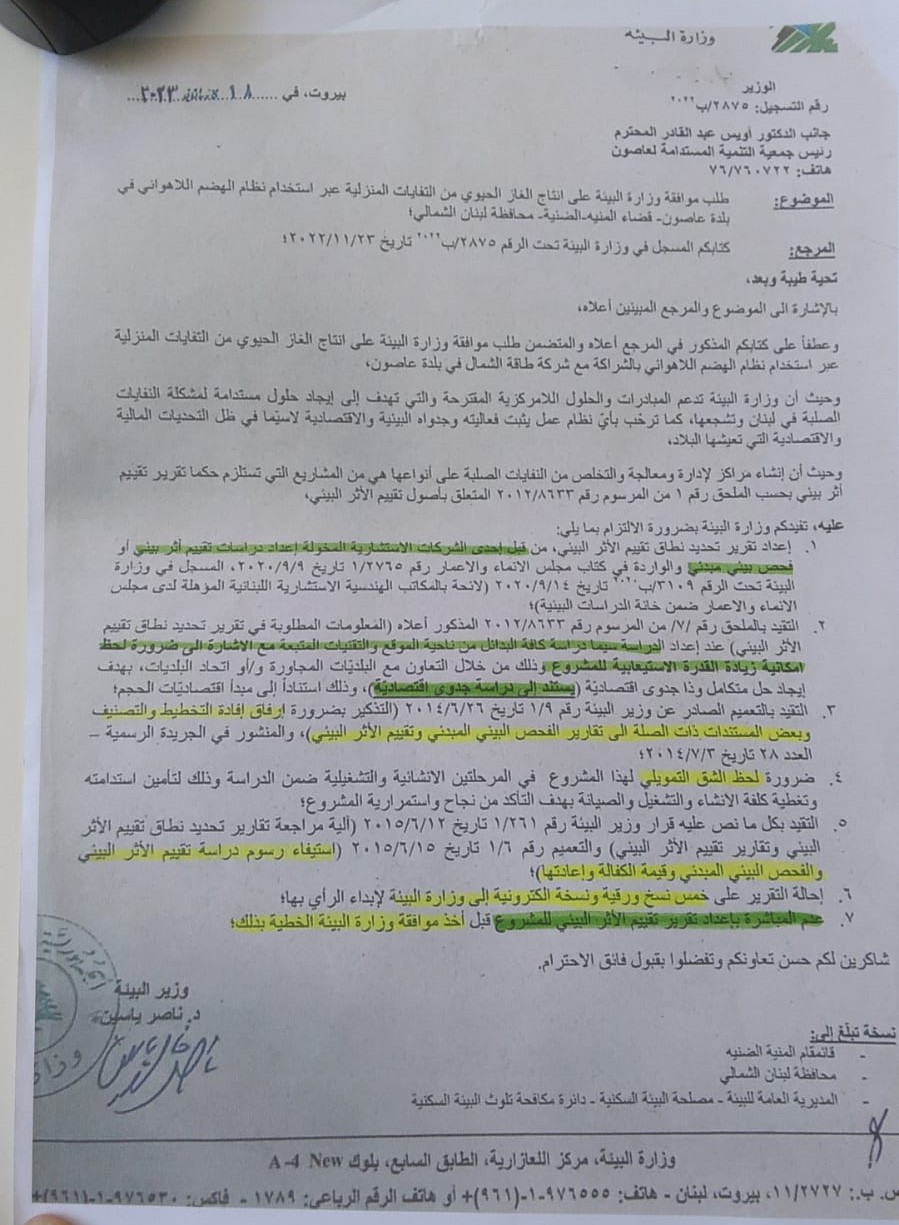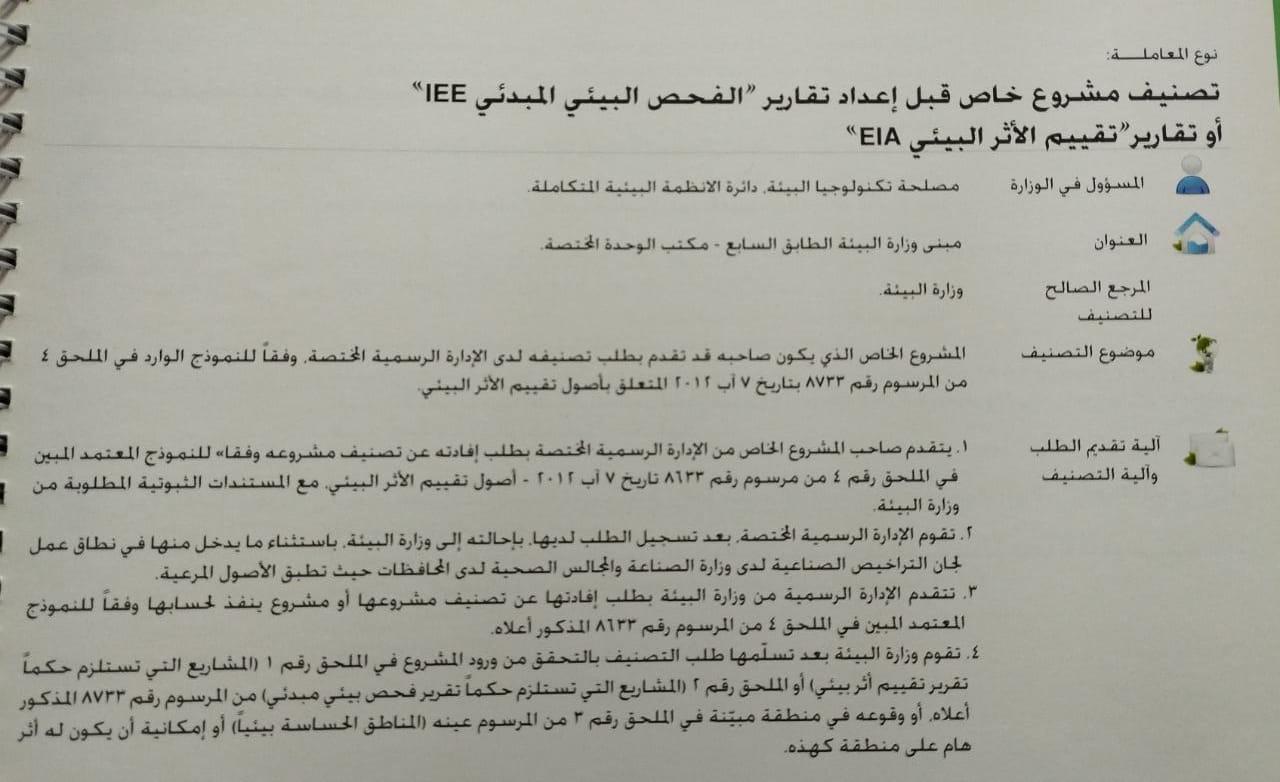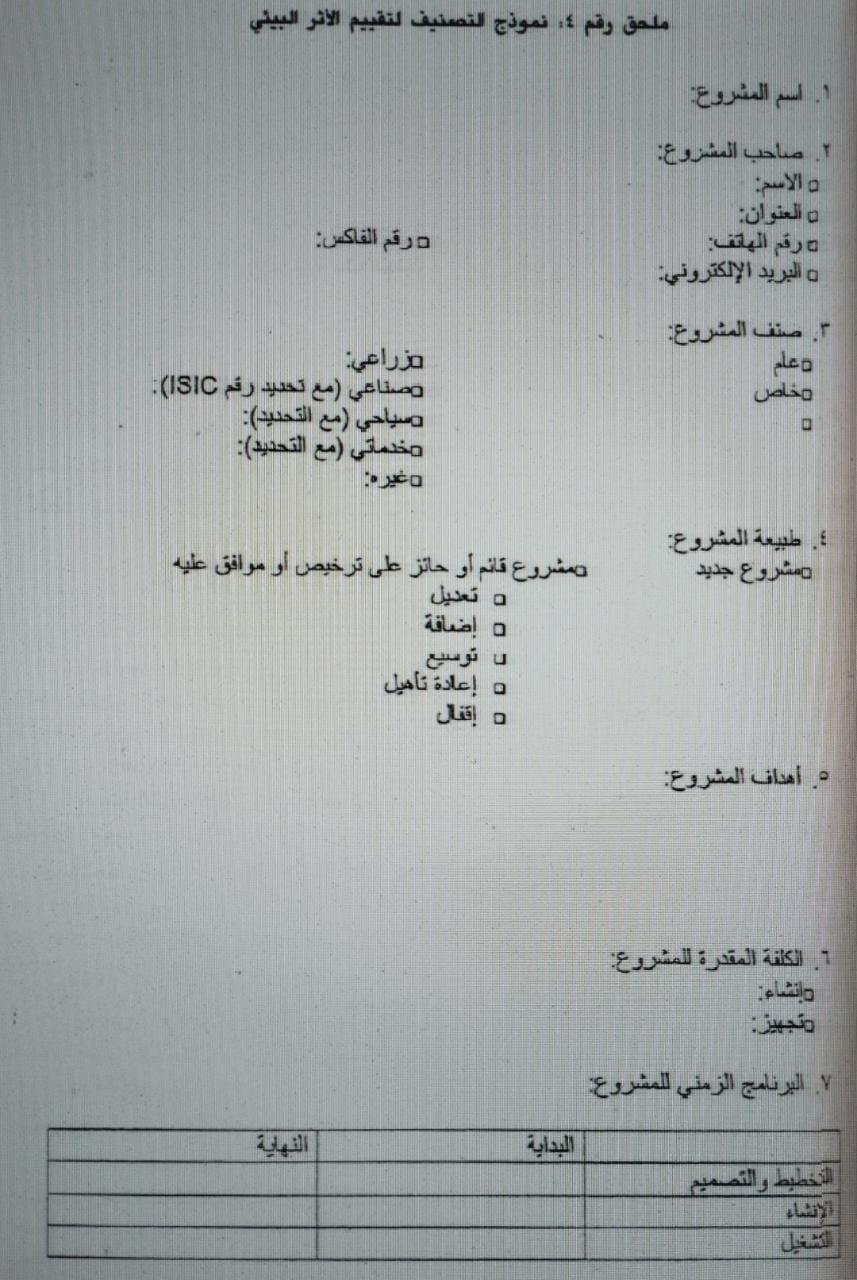- Hits: 2023
EIA assoun project

EIA - نموذج التصنيف لتقييم الأثر البيئي [docx file] (last update: 23.5.24, Author: Mariam El Rez)
EIA - CDR Consultancy firms list-2023 [pdf file] (لائحة بالمكاتب الهندسية الاستشارية اللبنانية المؤهلة لدى مجلس الانماء والاغمار ضمن خانة الدراسات البيئية )
EIA - Biogas & fertilizer production project at Aassoun (docx file)
EIA - Biogas & fertilizer production project at Aassoun (pdf file)
EIA Assoun power plant (.docx)
Details of project applicant and environmental assessment practitioner:
Details of project applicant:
|
Name of operation |
|
|
Applicant |
|
|
Postal address |
|
|
Responsible person |
|
|
Telephone no. |
|
|
E-mail address |
|
|
Company registration no. |
|
Description of the property
|
Application area (ha) |
|
|
|
Local minimality |
|
|
|
Distance and direction from nearest from |
|
|
Locality of the project:
Map
Description of the scope of the proposed overall activity:
- The existing Assoun Power plant has the following environmental authorization and licenses.
Description of the activities to be undertaken
Biogas is a renewable type of energy that is produced from the anaerobic digestion of organic waste (Ghe and Mare, 2013). During biogas production, the organic waste is converted to methane (55-70%), carbon dioxide (30-45%) and trace components which include hydrogen sulphide (<2%), water vapour ( 2-7%), oxygen (<2%) and ammonia (<2%). A solid residue, digestate is also produced and has potential to be used as an organic fertilizer (ref). Sewage sludge from municipal plants are also an attractive source of raw material for biogas production, however its processing have environmental and health considerations that must be put in place. The biogas production process.
Environmental Impact Assessment (EIA) considers the likely effects of the wet and dry processing on the environment. The assessment can then be used to reduce or prevent the negative effects of the activity on the environment and enhance the positive effects for development. A case study for the EIA considerations for setting up a biogas plant was done for a municipal biowaste treatment plant in Assoun.
The assoun power plant is a renewable energy industrial facility that is located (-) (0)
The existing biogas plant is ……. MW.
The Adv process to recover value from organic wastes (fruits, vegetables), chicken, sludge, food and beverage waste and cattle manure to generate biogas for power production.
The AD process converts organic matter /waste into biogas, a source of renewable energy, and a nutrient rich organic fraction knows as digestate will also be produced as a by-product.
Assoun power plant:
Comprised of the following infrastructure:
- Digestor tank
- Mixing tank
- Blowers
- Generator
- Capacitiy
- Condensate pit
- Desulphurization scrubber that is an integral part of the gas phase
- Gas cooling
- De-watering system
Policy and legislative context of biogas:
The legislative is certainly a positive step towards the large scale take up of renewable gas in the next decade. It will facilitate the access of biomethane to the natural gas grid, extend guarantees of origin from renewable gas, and make the cross border trade of biomethane easier. The new sustainability policy will restrict the production of biogas and biomethane however by introducing sustainability for all energy sectors.
Biogas and biomethane must reached 65%-85% greenhouse gas savings relative to the fossil fuel comparators.
Sustainable feed stock types are listed an Annex of the directive and the annexe determines the default emission valuers of different pathways.
The Annexe are kept under continuous review.Biogas nevertheless remains one of the most sustainable energy savings when the use agriculture manure as a feedstock methane emission from manure are avoided.
The directive must be transposed into Ntional law in all EU member by 30 june 2021.
Article 47 Emblem of the Union Member States, managing authorities and beneficiaries shall use the emblem of the Union in accordance with Annex IX when carrying out visibility, transparency and communication activities.
Article 49 Responsibilities of the managing authority 1. The managing authority shall ensure that, within 6 months of the decision approving the programme, there is a website where information on programmes under its responsibility is available, covering the programme’s objectives, activities, available funding opportunities and achievements. 2. The managing authority shall ensure the publication on the website referred to in paragraph 1, or on the single website portal referred to in point (b) of Article 46, of a timetable of the planned calls for proposals, that is updated at least three times a year, with the following indicative data: (a) geographical area covered by the call for proposal; (b) policy objective or specific objective concerned; (c) type of eligible applicants; (d) total amount of support for the call; (e) start and end date of the call. 3. The managing authority shall make the list of operations selected for support by the Funds publicly available on the website in at least one of the official languages of the institutions of the Union and shall update that list at least every 4 months. Each operation shall have a unique code. The list shall contain the following data: (a) in the case of legal entities, the beneficiary’s and, in the case of public procurement, the contractor’s name; (b) where the beneficiary is a natural person the first name and the surname; (c) for EMFAF operations linked to a fishing vessel, the Union fishing fleet register identification number as referred to in Commission Implementing Regulation (EU) 2017/218 ( 47); (d) name of the operation; (e) the purpose of the operation and its expected or actual achievements; (f) start date of the operation; (g) expected or actual date of completion of the operation; (h) total cost of the operation; (i) fund concerned; (j) specific objective concerned; (k) Union co-financing rate; (l) location indicator or geolocation for the operation and country concerned; (m) for mobile operations or operations covering several locations the location of the beneficiary where the beneficiary is a legal entity; or the NUTS 2 level region where the beneficiary is a natural person; (n) type of intervention for the operation in accordance with point (g) of Article 73(2). For data referred to in points (b) and (c) of the first subparagraph, the data shall be removed 2 years from the date of the initial publication on the website. 4. The data referred to in paragraphs 2 and 3 of this Article shall be published on the website referred to in paragraph 1, or on the single website portal referred to in point (b) of Article 46 of this Regulation, in open, machine-readable formats, as set out in Article 5(1) of the Directive (EU) 2019/1024 of the European Parliament and of the Council ( 48), which allows data to be sorted, searched, extracted, compared and reused.
- The managing authority shall inform the beneficiaries that the data will be made public before the publication takes place in accordance with this Article. 6. The managing authority shall ensure that communication and visibility material including at the level of beneficiaries is made available upon request to Union institutions, bodies, offices or agencies and that a royalty-free, non-exclusive and irrevocable licence to use such material and any pre-existing rights attached to it is granted to the Union in accordance with Annex IX. This shall not require significant additional costs or a significant administrative burden for the beneficiaries or for the managing authority. Article 50 Responsibilities of beneficiaries 1. Beneficiaries and bodies implementing financial instruments shall acknowledge support from the Funds, including resources reused in accordance with Article 62, to the operation by: (a) providing on the beneficiary’s official website, where such a site exists, and social media sites, a short description of the operation, proportionate to the level of support, including its aims and results, and highlighting the financial support from the Union; (b) providing a statement highlighting the support from the Union in a visible manner on documents and communication material relating to the implementation of the operation, intended for the public or for participants; (c) displaying durable plaques or billboards clearly visible to the public, that present the emblem of the Union in accordance with the technical characteristics laid down in Annex IX, as soon as the physical implementation of operations involving physical investment starts or purchased equipment is installed, in respect of the following: (i) operations supported by the ERDF and the Cohesion Fund the total cost of which exceeds EUR 500 000; (ii) operations supported by the ESF+, the JTF, the EMFAF, the AMIF, the ISF or the BMVI the total cost of which exceeds EUR 100 000; (d) for operations not falling under point (c), displaying at a location clearly visible to the public at least one poster of a minimum size A3 or equivalent electronic display with information about the operation highlighting the support from the Funds; where the beneficiary is a natural person, the beneficiary shall ensure, to the extent possible, that appropriate information is available, highlighting the support from the funds, at a location visible to the public or through an electronic display; (e) for operations of strategic importance and operations the total cost of which exceeds EUR 10 000 000, organising a communication event or activity, as appropriate, and involving the Commission and the responsible managing authority in a timely manner. Where an ESF+ beneficiary is a natural person or for operations supported under the specific objective set out in point (m) of Article 4(1) of the ESF+ Regulation, the requirement set out in point (d) of the first subparagraph shall not apply. By derogation from points (c) and (d) of the first subparagraph, for operations supported by the AMIF, the ISF and the BMVI, the document setting out the conditions for support may establish specific requirements for the public display of information on the support from the Funds where this is justified by reasons of security and public order in accordance with Article 69(5). 2. For small project funds, the beneficiary shall comply with the obligations under Article 36(5) of the Interreg Regulation. For financial instruments, the beneficiary shall ensure by means of the contractual terms that final recipients comply with the requirements set out in point (c) of paragraph 1. 3. Where the beneficiary does not comply with its obligations under Article 47 or paragraphs 1 and 2 of this Article, and where remedial actions have not been put into place, the managing authority shall apply measures, taking into account the principle of proportionality, by cancelling up to 3 % of the support from the Funds to the operation concerned.
Annexe 6
Article 69
Responsibilities of Member States
- Member States shall have management and control systems for their programmes in accordance with this Title and ensure their functioning in accordance with the principle of sound financial management and the key requirements listed
Effects of some common biogas impurities to human health, environment and process equipment.
|
Biogas impurities |
Threshold limit to health and the env't. |
Effects on human health and the environment |
Effects to process equipment |
References |
|
Hydrogen sulphide |
1Odor: < 0.014 mg/m3 |
2,5,9Hazardous to environment, forming SO2 and SO3 and acid rain (H2SO4) |
Highly corrosive,6,7 poisoning to the catalytic converter8 |
1,Drimal et al. (2010),2,Rubright et al. (2017),3,Axelsson et al. (2012),4,Roth (2004), 5,Lim et al. (2016), 6,Guidotti (1994), 7,Tang et al. (2010), 8,Awe et al. (2017), Paolini et al. (2018b), 9,Atelge et al. (2021), |
|
Siloxanes |
- |
No environmental effect1, only “responsible for fouling in the post-combustion emissions control catalytic system”.2 |
Formation of “glassy micro-crystalline silica” that decreases life span of equipment.2,3 |
1,Graiver et al. (2003),2,Soreanu et al. (2011),3,Arnold (2009) |
|
Ammonia |
Max. emission rate: <50 ppmv.1 |
Formation and emission of NOx after combusion.3 |
Corrosion, anti-knock properties to engines5, NH3 is less corrosive than H2S.4 |
1,Mojtahedi and Abbasian (1995), 2,Wendt and Sternling (1974), 3,Ranalli (2007), 4,Francis (1985), 5,Awe et al. (2017), 6,Atelge et al. (2021) |
|
Nitrogen |
- |
No harmful environment effect.1 |
Reducing the calorific value, corrosion and anti-knock properties2 |
|
|
|
|
|
|
|
|
Water vapour |
- |
Water vapour forms acids with CO2 and H2S.2 |
1Corrosion due to the reactions with NH3 |
|
|
Particulate matter |
<20 μg/m3 for 24 h and for particle size of <2.5 μm < 2.5 μm.1 |
- |
- Plugs the gas system and pores of the adsorbent.2 |
|
|
|
|
|
|
|
Emissions
The storage of feedstock and digestate in open tanks, as well as their mechanical treatment, may cause emissions of the nitrogen (N) gases ammonia (NH3) and nitric oxide (NO), as well as N2O, CH4, odour and dust. Anaerobic digestion is carried out in gas-tight vessels, and fugitive air emissions are unlikely to occur except during transfer to and from the digester and storage of feedstocks and digestate. However, fugitive emissions of biogas are possible from emergency vent valves and from poorly sealed water traps. The emissions generated by the combustion of the biogas are addressed separately in Chapter 1.A.1. This chapter (Chapter 5.B.2) considers the potential for NH3 emissions from the following sources of biogas facilities: 1. during storage of feedstock on the premises of the biogas facility ( 1 ); 2. during storage of the digestate. Agricultural crops used for biogas production (energy crops) are commonly stored as silage. As the pH of silage is low for conservation purposes, NH3 emissions resulting from the storage of energy crops before anaerobic digestion are negligible. As the digester is completely enclosed, no NH3 emissions should occur. In the operation of a biogas plant however, instances of excess pressure might occur. In these cases, pressure valves might release some biogas (approximately 1 % of gas produced). For greenhouse gas calculations, these losses are relevant, as about 60 % of the gas volume is methane. The concentration of NH3 in biogas is far lower (0.1–1 %), depending on the substrates being fermented. For most digestion processes, the leakage losses will therefore be less than 0.05 % of the nitrogen (N) content of the resulting digestate. Therefore, this source is here considered negligible. Emissions of NO, odour and dust from anaerobic digestion at biogas facilities are not considered because they are likely to be insignificant.
Carbon dioxide emissions
Harmful compounds and air contaminants are introduced into the environment during biogas production and use through both combustion processes and diffusive emissions. Considering carbon dioxide, combustion of biogas leads to efficient methane oxidation and conversion to CO2, with a rate of 83.6 kg per GJ (based on a biogas with 65% CH4 and 35% CO2[Citation25]). Other releases of this contaminant are related to transport and storage of biomass, as well as digestate use. In the case of both biogas combustion and biomass/digestate emission, CO2 is considered as biogenic and calculated neutral with regards to the impact on climate. Taking into account the reduction of fossil fuel, it can be demonstrated that biogas production leads globally to mitigation of anthropogenic greenhouse impact of the environment. Poeschl and co-workers[Citation26] have investigated the CO2 emissions associated to biogas production from several feedstocks, and the relative contribution of feedstock supply, biogas plant operation and infrastructure, biogas utilization and digestate management. According to this study, biogas use gives rise to a negative CO2 balance because CO2 caption results every time higher, in absolute values, than positive emissions from feedstock supply and biogas plant operation. As expected, biogas production from byproducts (e.g. from food residues, pomace, slaughter waste, cattle manure, etc.) is a more sustainable approach than energy crops utilization such as whole-wheat plant silage. Besides, digestate management provides significant contributions to total emission reduction in the case of specific feedstock such as municipal solid waste.
Preliminary environment impact assessment:
The environment impact assessment is done in all stages of a project from the planning construction, operation and decommissioning stages. The negative and positive impacts and mitigation measures at each stage are analyzed.
Planning stage: this stage has little or no impact to the environmental it is administrative in nature as the various stakeholders are informed and goals are set. The stakeholders include the Chiefs, EMA and District administrators in reference to the governing act that affect the biogas plant project.
The table shows the impacts and mitigation at the construction, operation and decommissioning stage that can be encountered during biogas plant setting up, operation commissioning and decommissioning stages.
|
Stage |
Negative impacts |
Positive impacts |
Mitigation measures |
|
Construction |
Disruption of fauna and flora |
Construction of access road |
Selective cleaning of areas |
|
Wildlife will flee because of noise |
Creation of settlement area |
Isolation of the area being constructed |
|
|
Disruption of ecosystem by tree and bush clearing |
Development of area due to structural buildings like clinics, shops and schools as well as dams |
Using dampening effect instruments to minimize vibration which will affect the wildlife |
|
|
Dust emissions during construction |
|
Personnel working should wear protective clothing like ear muffs |
|
|
High levels of noise during construction |
|
|
|
|
Migration of people to seek for work |
|
|
|
|
Exerts pressure on the available land |
|
|
|
|
Operation |
High level of noise crushing equipment |
Employment equipment |
Provision of ear muffs |
|
Air quality is affected because of dust |
Continual development of the area |
Use of bag filters to minimize emissions into air |
|
|
Rapture of machinery in particular fluidized bed separator |
No production of tailings, thus minimal/ no pollution to the rivers |
Stringent control on the equipment with safety trips and alarms |
|
|
Decommissioning |
Idle buildings |
Equipment can be sold to give salvage money |
Continuous rehabilitation by back filing of the gangue to the mind areas since the gangue is chemically inert (no chemical usage in the process) |
|
The inability of the land to be rehabilitated |
-the buildings can be sold or leased for the same purpose of mining or another line of work |
|
Impact Description:
|
Environment component |
Activity |
Impact description |
Duration |
|
Soil |
Operation of the infrastructure to the existing Assoun Biogas power plant |
Soil pollution due to hydrocarbons including fuel, greases and oil used on site during the upgrade activities or spil event associed with the upgrade activities. |
Operational phase |
|
Groundwater |
Operation of the infrastructure to the existing Assoun Biogas power plant |
Groundwater pollution due to activities undertaken for the upgrade that may include · Potential spills of hazardous chemical substances including fuel, greases and oils used on site during maintenance activities · Groundwater contamination from liquid and solid wastes stored on site in above ground concrete tank and skip. Irrigation of lands with affected water not meetings the irrigation requirements. |
Operational phase |
|
Storm and water management |
Operation of the infrastructure to the existing Assoun Biogas power plant |
Incorrect storm water management on site for the additional infrastructure on site that are related to the upgrade |
Operational phase |
|
Noise |
Operation of the infrastructure to the existing Assoun Biogas power plant |
Ambient noise levels are likely to increase as a result of additional infrastructure on site that are related to the upgrade |
Operational phase |
|
Atmospheres, and odor |
Operation of the infrastructure to the existing Assoun Biogas power plant |
Deterioration of air quality and unwanted odors associated with the upgrade |
Operational phase |
|
Socio-economic |
Operation of the infrastructure to the existing Assoun Biogas power plant |
Providing additional electricity to the already strained power supply grid |
Operational phase |
|
Sourcing of local and services |
Operational phase |
||
|
Waste management |
Operation of the infrastructure to the existing Assoun Biogas power plant |
Incorrect disposal of waste and not in accordance with the existing waste licence |
Operational phase |
المعلومات المطلوبة في التقرير المتعلق بتحديد نطاق تقييم الأثر البيئي
1 - مقدمة:
تحدد هذه الفقرة الهدف من التقرير المتعلق بتحديد نطاق «تقييم الأثر البيئي» وتعرف بالمشروع موضوع الدراسة وتشرح التدابير التنفيذية ل «تقييم الأثر البيئي».
2 - معلومات مرجعية:
تتضمن هذه الفقرة المعلومات ذات العلاقة بالفرقاء المحتملين الذين قد يقوموا بدراسة «تقييم الأثر البيئي»، وتحقيق مختصر عن المحتويات الأساسية للمشروع المقترح، وتصريح عن ضرورة المشروع والحاجة إليه وعن الأهداف التي يبتغيها، والمكتب المنفذ، وملخص لتاريخ المشروع بما فيه البدائل التي تم درسها والمشاريع المرتبطة به. وتتم الإشارة الى أية مشاريع قيد التنفيذ أو مخطط لها في ذات المنطقة قد تكون منافسة للمشروع المدروس بالنسبة لوحدة الموارد.
3 - الأهداف:
تحدد هذه الفقرة نطاق «تقييم الأثر البيئي» وتناقش توقيته بالنسبة لمراحل إعداد المشروع وتصميمه وتنفيذه.
4 - متطلبات تقييم الأثر البيئي:
تحدد هذه الفقرة أية تنظيمات وتوجيهات تنظم إجراء «تقييم الأثر البيئي» أو تحدد مضمون التقرير المتعلق بتحديد نطاق «تقييم الأثر البيئي».
5 - منطقة الدراسة:
تحدد هذه الفقرة حدود المنطقة التي تغطيها الدراسة لأغراض «تقييم الأثر البيئي». وإذا كانت هناك أية منطقة محاذية أو بعيدة يجب أن تدرس في ما يتعلق بالآثار المحتملة لتنفيذ أو إدارة هذا المشروع، فيجب أن تدرج في التقرير المتعلق بتحديد نطاق «تقييم الأثر البيئي».
6 - نطاق العمل:
في بعض الحالات يمكن معرفة المهمات التي يتعين على صاحب المشروع القيام بها بشكل واضح يتيح تحديدها بالكامل في التقرير المتعلق بتحديد نطاق «تقييم الأثر البيئي». إنما في حالات أخرى، تظهر الحاجة الى إجراء دراسات ميدانية متخصصة أو وضع نماذج بغية تقييم الآثار التي يمكن أن يسفر عنها المشروع المقترح، عندها يطلب من صاحب المشروع تحديد هذه المهام المعينة بمزيد من التفصيل، ويشمل نطاق العمل النقاط التالية:
6 - 1) إطار السياسات والأطر القانونية والإدارية:
تحقيق حول الأنظمة المطبقة والمبادئ والمواصفات المعمول بها في قطاع البيئة محلياً ووطنياً (تحدد الدراسة الاعتبارات المعروفة ويطلب من صاحب المشروع أن يتحقق من وجود اعتبارات أخرى) وتحديد التشريعات التي تحكم القطاع الذي يندرج تحته المشروع. هذه المعلومات يجب أن تتناول تحديد الإدارة الرسمية المختصة وإمكانياتها على المستوى المحلي والوطني.
6 - 2) المساعدة في التنسيق بين الإدارات الرسمية ومشاركة العامة:
المساعدة في تنسيق الدراسة مع الإدارات الرسمية وفي الحصول على رأي المنظمات غير الحكومية المحلية والمجموعات التي تتأثر بالمشروع المقترح وفي حفظ محاضر الاجتماعات وسائر النشاطات والاتصالات والتعليقات وأسلوب التصرف بها (ويحدد التقرير المتعلق بتحديد نطاق «تقييم الأثر البيئي» أنواع النشاطات مثل اجتماع تحديد نطاق العمل تشارك فيه الجهات المعنية وجلسات إعلامية في قطاع البيئة لموظفي المشروع، ومساندة المستشارين في قطاع البيئة، وندوات عامة الخ.).
6 - 3) وصف المشروع المقترح:
وصف أجزاء المشروع وبيان الخرائط المتعلقة بها على المقياس المناسب وصور، واظهار المعلومات العائدة لموقع المشروع والتصميم الشامل والحجم والسعة وبرنامج العمل والخدمات ومدة التشغيل الخ.
6 - 4) وصف البيئة المحيطة بالمشروع:
جمع وتقييم المعلومات الرئيسية حول الخصائص البيئية لموقع الدراسة (البيئة الفيزيائية والكيميائية والبيولوجية والإجتماعية والإقتصادية) مع الأخذ بعين الاعتبار أية تعديلات متوقعة قبل بدء المشروع وأية تغيرات مستقبلية محتملة.
6 - 5) الآثار البيئية المحتملة للمشروع:
يجب التمييز بين الآثار الإيجابية والآثار السلبية، الآثار المباشرة والآثار غير المباشرة، الآثار على المدى القصير والآثار على المدى الطويل. ويجب تحديد الآثار الدائمة التي لا يمكن تجنبها وتحديد الآثار الكونية وتلك عبر الحدود. على صاحب المشروع أن يصف وسائل وتقنيات التقدير المستعملة لتقييم آثار المشروع على البيئة. يتم تحديد نطاق ونوعية المعلومات المتوفرة، مع شرح الفجوات الهامة في المعلومات وأية احتمالات مجهولة في ما يتعلق بإمكانية
تقدير الآثار المحتملة للمشروع المقترح. من المستحسن عرض دفاتر الشروط لبعض الدراسات المزمع إجراؤها بهدف الحصول على المعلومات الناقصة. يجب أن تظهر هذه الفقرة التدابير التخفيفية الممكنة لكل اثر وتوحي بالتدابير الأجدى والأقل كلفة.
6 - 6) تحليل البدائل للمشروع:
وصف مبدئي بشكل عام للبدائل التي تم دراستها خلال إعداد المشروع المقترح وذكر هذه البدائل الأخرى التي يمكن أن تحقق الأهداف ذاتها. يشمل مفهوم هذه البدائل بشكل عام اختيار موقع المشروع وتصاميمه والتكنولوجيا الخاصة به، وأساليب التشييد مع تحديد مراحله، وإجراءات تشغيله وصيانته. كما يتم مقارنة مبدئية عامة لهذه البدائل من حيث الآثار البيئية المحتملة، وتكاليفها من حيث رأس المال والتشغيل، وملاءمتها للأوضاع المحلية، والمتطلبات المؤسساتية والتدريبية ومتطلبات الرصد والمراقبة. ويجب، ضمن الممكن، تحديد مبدئي بشكل عام لكلفة وأرباح كل البدائل، إضافة الى الكلفة المقدرة للتدابير التخفيفية. كما يجب إدراج البديل المتمثل في عدم إنشاء المشروع، بغية إيضاح الأوضاع البيئية حسب ما هي بدون المشروع
6 - 7) خطة الإدارة البيئية:
التدابير التخفيفية للآثار السلبية
- خطة الرصد والمراقبة
- خطة تنمية القدرات المؤسساتية لتنفيذ التوصيات المدرجة في «تقييم الأثر البيئي».
على صاحب المشروع أن يعد خطة مفصلة لإدارة البيئة تشمل التدابير التخفيفية للآثار السلبية كافة وبرنامج الرصد والمراقبة واحتياجات العاملين والمؤسسات لتطبيق هذه التدابير. كما يجب تحديد كلفة هذه الخطة بما فيها التعويض على المتضررين من جراء الآثار غير القابلة للتخفيف.

21.3.24:
Dr Ouaiss talked to Mr. Mohammad concerning EIA





